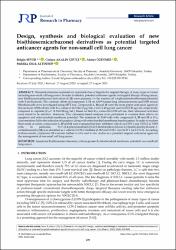Design, synthesis and biological evaluation of new bis(thiosemicarbazone) derivatives as potential targeted anticancer agents for non-small cell lung cancer

Göster/
Erişim
info:eu-repo/semantics/openAccessTarih
2020Yazar
Anadolu Üniversitesi, Eczacılık Fakültesi, Farmasötik Kimya Anabilim Dalı
0000-0003-4847-9711
0000-0001-5098-8967
0000-0003-0280-5550
0000-0002-8159-663X
Sever, Belgin
Akalın Çiftçi, Gülşen
Özdemir, Ahmet
Altıntop, Mehlika Dilek
Üst veri
Tüm öğe kaydını gösterKünye
Sever B, Akalın Çiftçi G, Özdemir A, Altıntop MD. Design, synthesis and biological evaluation of new bis(thiosemicarbazone) derivatives as potential targeted anticancer agents for non-small cell lung cancer. J Res Pharm. 2020; 24(5): 670-680.Özet
Thiosemicarbazonesrepresent an important class of ligandsfortargeted therapyof many types of cancer including non-small celllung cancer. In order to identify potential antitumoragentsfor targeted therapy oflung cancer, new bis(thiosemicarbazone) derivatives (1-11) were preparedviathe reaction of 1,4-phenylenebis(thiosemicarbazide) with 5-arylfurfurals. The cytotoxic effects of compounds 1-11on A549human lung adenocarcinoma and L929 mouse fibroblast cellswere investigated using MTT test. Compounds 1, 10and 11were the most potentanticancer agents in this series on A549 cell line with IC50values of 14.33±0.47 μg/mL, 11.67±2.49 μg/mL and16.67±5.56 μg/mL, respectivelycompared to cisplatin (IC50= 18.33±0.94μg/mL). Based on theirIC50values for L929 cell line, their anticancer activitieswere found to be selective.Moreover,flow cytometry-based analyseswere performed to examine their effects on apoptosis and mitochondrial membrane potential.The treatment of A549 cells with compounds 1, 10and 11 at IC50 concentrationsled to the induction of apoptosis along with mitochondrial membrane depolarization. In order to explore theirmodeof action,compounds 1, 10 and 11were evaluated for their inhibitory effects onCOX-1 and COX-2 in A549 cells. In particular, N,N'-(1,4-phenylene)bis(2-((5-(2,5-dichlorophenyl)furan-2-yl)methylene)hydrazine-1-carbothioamide) (10) was identified as a selectiveCOX-2 inhibitor(6.96% for COX-1 and 54.81% for COX-2). According to these results, compound10warrants further in vitroand in vivostudies as a potential targeted anticancer agentfor the management of non-small celllung cancer.
Kaynak
Journal of Research in PharmacyCilt
24Sayı
5Bağlantı
https://hdl.handle.net/11421/25620Koleksiyonlar
- Makale Koleksiyonu [86]
- Makale Koleksiyonu [317]
- Scopus İndeksli Yayınlar Koleksiyonu [8325]
- TR-Dizin İndeksli Yayınlar Koleksiyonu [3512]

















